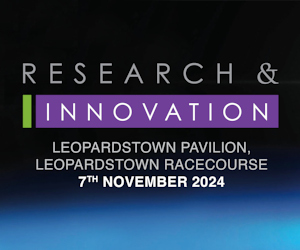Teagasc Research Impact in 2018

Teagasc has published ‘Teagasc Research Impact Highlights in 2018’. In any given year, the impact of Teagasc research is a combination of the continuing impact of past research, and the new impact of recent research.
“This publication highlights some of these new impacts achieved in 2018. The examples selected are from across our programme and range from research conducted on issues in soils and the environment, animal production, crop production, food processing, food and health, to economics and social science,” said Professor Frank O’Mara, Director of Research in Teagasc. “While our researchers published almost 600 peer reviewed scientific papers in 2018, as an organisation that conducts mainly applied research, we work hard to ensure our research programmes will have impact and are relevant to the Irish agricultural and food sectors.”
Beefing up dairy-beef cattle
 The expanding dairy herd, coupled with improving reproductive performance, will necessitate that a greater proportion of slaughtered cattle in Ireland will originate from dairy herds. However, the genetic antagonism in cattle between carcass merit and the extent of assistance required at calving demands an index that combines the desired genetic attributes from the perspective of the dairy producer (i.e., easy calving, short gestation) with those of the beef producer and industry as a whole (i.e., efficiency of growth of valuable meat). A profit-based breeding index with eight traits was developed, and subsequently deployed by the Irish Cattle Breeding Federation, to improve the carcass merit of the delivered calf with minimal consequences on the dairy cow. Dr Donagh Berry, Teagasc Moorepark explains: “The breeding index will be used by dairy farmers for selecting suitable beef bulls for use on their dairy females, but will also be used by beef bull breeders to breed the next generation of beef bulls demanded by dairy producers.”
The expanding dairy herd, coupled with improving reproductive performance, will necessitate that a greater proportion of slaughtered cattle in Ireland will originate from dairy herds. However, the genetic antagonism in cattle between carcass merit and the extent of assistance required at calving demands an index that combines the desired genetic attributes from the perspective of the dairy producer (i.e., easy calving, short gestation) with those of the beef producer and industry as a whole (i.e., efficiency of growth of valuable meat). A profit-based breeding index with eight traits was developed, and subsequently deployed by the Irish Cattle Breeding Federation, to improve the carcass merit of the delivered calf with minimal consequences on the dairy cow. Dr Donagh Berry, Teagasc Moorepark explains: “The breeding index will be used by dairy farmers for selecting suitable beef bulls for use on their dairy females, but will also be used by beef bull breeders to breed the next generation of beef bulls demanded by dairy producers.”
IPM strategies for septoria tritici blotch
Septoria tritici blotch (STB) caused by Zymoseptoria tritici continues to be the most economically destructive disease of Irish winter wheat crops. As a wet weather disease, Irish crops are at considerable risk and, as such, Irish farmers must apply fungicides to protect potential yields. Unfortunately, this combination has meant that the Irish Zymoseptoria tritici population has developed resistance to the main fungicides used for its control. In light of these changes, and continued regulatory pressures on the availability of multisite fungicides, Teagasc research is ongoing to determine the best means to ensure that Irish winter wheat crops are protected, but equally to discover how best to manage resistance to current and future fungicide chemistries. Dr Steven Kildea, Teagasc Oak Park, explains: “To achieve these goals Teagasc combines detailed sensitivity monitoring with an extensive programme of field trials throughout the main wheat growing regions in Ireland. These have resulted in an increased awareness of the need to maximise the concept of integrated pest management in cereal disease control programmes, with increased emphasis being placed on both varietal choice and agronomic practices used by growers.”
Novel procedure to generate bioplastics
The food and packaging industries are keen on adapting novel biomaterials to reduce the current dependency on petrol-based materials. Also, the EU is demanding a reduction in the generation of food waste, encouraging its recovery, reutilisation and revalorisation. A novel method to generate transparent, food-grade and insoluble bioplastics from pork haemoglobin has been developed; it faces both issues by generating a novel biodegradable and sustainable material to partially replace petroleum-based materials, while blood from meat processors is revalorised. Dr Carlos Álvarez, Teagasc Food Research Centre, Ashtown, describes the applications for such products: “Such technology has the potential to be transferred to other protein-based films, the high solubility of which restricts the range of applications. It also unlocks the potential of using wasted proteins as a renewable source for many applications, such as food packaging, bioactive carriers or even biomedicine.”
Future levels of Irish agricultural greenhouse gas and ammonia emissions
The future level of agricultural activity in Ireland is subject to considerable uncertainty for several reasons. These would include: the outcome of Brexit; potential EU trade agreements with third countries; the future size of the EU budget (2021 to 2027); and, the next Common Agricultural Policy (CAP) reform. To take account of such uncertainty, six different scenarios were developed to scope out the size of the Irish agricultural sector in the future. This largely involved making differing assumptions about how the dairy and beef sector would evolve in the period to 2030, as these sectors are the principal source of Irish agricultural greenhouse gas (GHG) emissions. This then allowed projections to be made about how Irish agricultural GHG and ammonia emissions might evolve to 2030. Trevor Donnellan, Teagasc Rural Economy and Development Programme, explains: “These emissions could then be compared with potential emission reduction targets to see how much of a gap would need to be filled through actions designed to mitigate GHG and ammonia emissions from the sector.”
Using research from a separate study, which developed marginal abatement cost curves (MACC) for agricultural GHG and ammonia emissions, it was then possible to determine the likely level of future emissions that could result under the various scenarios and the implications for Ireland’s compliance with GHG and ammonia targets.
The ‘Teagasc Research Impact Highlights 2018’ document is available for download at: http://bit.ly/ResearchImpact2018Teagasc.







